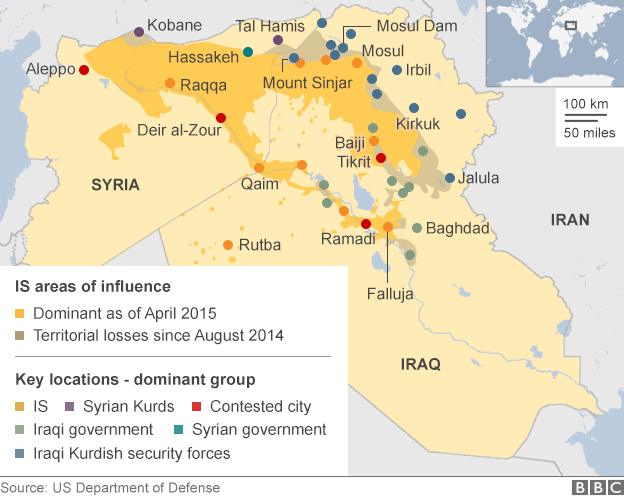Islamic State: What has happened since the fall of Mosul?
- Published
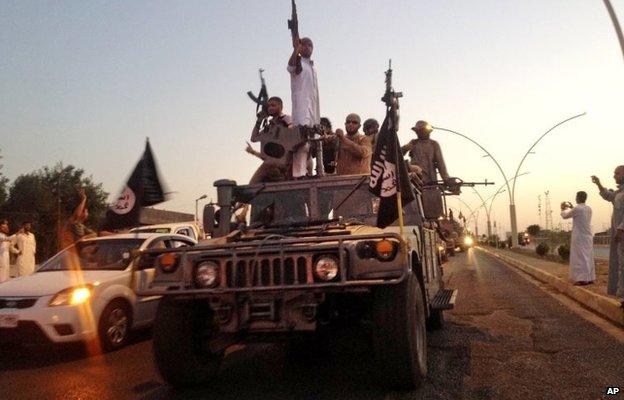
A year ago, militants from Islamic State (IS) seized control of Iraq's second city, Mosul, routing the Iraqi army and sending shockwaves around the world.
Despite facing an air campaign by a US-led international coalition and offensives on the ground by a variety of opponents in Iraq and neighbouring Syria, IS has maintained its grip on the territory it captured and been able to impose its extreme interpretation of Islamic law.
Here is a look at some of the key events which have shaped the confrontation with the jihadist group over the past 12 months.

Mosul captured
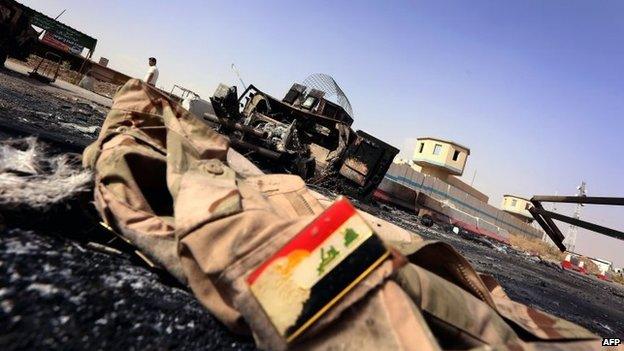
Isis acquired US-made weaponry abandoned by Iraqi soldiers as they fled Mosul
In early June 2014, the group then known as Islamic State in Iraq and the Levant (Isis) launched an assault on Mosul, the main city in northern Iraq. An estimated 30,000 soldiers fled when confronted by as few as 800 militants. In addition to gaining control of a major political and economic centre with a population of 1.8 million, Isis acquired US-made weaponry, including armoured vehicles.
Emboldened by the army's collapse, Isis militants swept southwards towards Baghdad, seizing much of the Sunni-dominated provinces of Nineveh and Salahuddin and parts of Diyala in a matter of days.
The images appear to show captured Iraqi soldiers in civilian clothes being led away by militants, as John Simpson reports
Some half a million Iraqis, many of them members of ethnic and religious minorities, fled their homes to escape the Isis onslaught.
The group ignited fear and anger among Iraq's Shia Arab majority by announcing it had killed as many as 1,700 mostly Shia soldiers based at Camp Speicher, external outside Tikrit - one of the worst atrocities committed in Iraq in recent times.

Caliphate declared
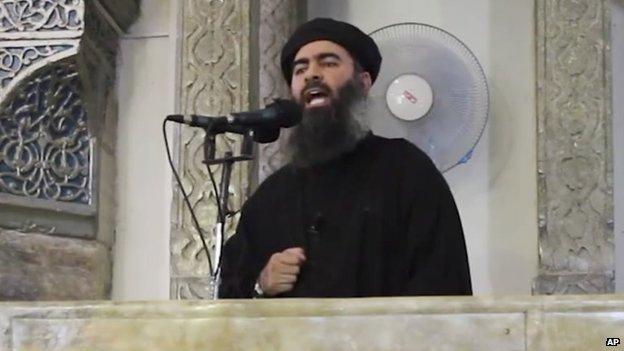
Abu Bakr al-Baghdadi enjoined Muslims to emigrate to IS territory at a mosque in Mosul
At the end of June 2014, after consolidating its hold over dozens of cities and towns in western and northern Iraq, Isis formally declared the establishment of a "caliphate" - a state governed in accordance with Sharia by God's deputy on Earth, or caliph. It named Abu Bakr al-Baghdadi as Caliph Ibrahim and demanded allegiance from Muslims worldwide. The group renamed itself Islamic State, dropping the mention of Iraq and the Levant.
IS footage purportedly shows a bulldozer merging the areas it has seized, as Frank Gardner reports
Five days later, a video was released showing Baghdadi delivering a sermon at Mosul's Great Mosque - his first public appearance in many years.
In the formal address that experts said bore similarities to those by caliphs in first centuries of Islam, Baghdadi enjoined Muslims to emigrate to IS territory in order to carry out a war for the faith against unbelievers, or jihad.

Yazidis enslaved

Yazidis stranded on Mount Sinjar eventually escaped with the help of Syrian Kurdish fighters
In August 2014, IS turned its sights on territory north and west of Mosul held by the armed forces of Iraq's semi-autonomous Kurdistan region, the Peshmerga.
Despite their fearsome reputation, the Peshmerga fled in the face of the offensive by better-armed militants. IS swiftly captured the important Mosul Dam, advanced on the Kurdish capital, Irbil, and sent minorities from the Nineveh plains fleeing.
Tens of thousands of Yazidis became stranded without food or water on Mount Sinjar after IS swept into nearby towns and villages, killing men and boys, and raping and enslaving women and girls.
Gabriel Gatehouse reports from the front line of Peshmerga-held territory in northern Iraq
The threat to Iraq's infrastructure and Americans in Irbil, as well as the humanitarian crisis on Mount Sinjar, prompted US President Barack Obama to authorise air strikes in northern Iraq. Mr Obama also put fresh pressure on Iraq's political parties to replace Nouri Maliki as prime minister. After Iran also withdrew its backing, Mr Maliki reluctantly agreed to step down in favour of a consensus candidate from his Shia Islamist party, Haider al-Abadi.
Yazidi women tell of sex-slavery trauma

Hostage killings
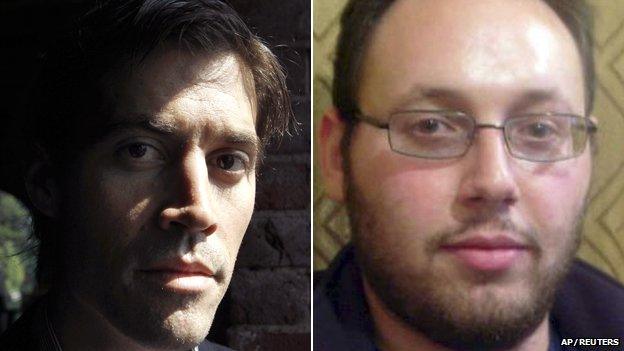
James Foley and Steven Sotloff were the first Western hostages to be beheaded by IS
Eleven days after the US launched air strikes in Iraq, IS released a video showing the beheading of the US journalist James Foley, who was abducted in Syria in 2012, stirred global outrage. In the video, entitled A Message to America, a masked British militant warned President Obama that if he did not halt the strikes another American journalist would die. A video showing his beheading of Steven Sotloff was released at the start of September 2014.
Jon Sopel reports: "Overnight US might was unleashed on extremists in Syria"
Mr Obama responded by forming an international coalition to "degrade and ultimately destroy" IS. He also authorised a major expansion of the military campaign against IS. Less than two weeks later, the US and its Arab allies began bombing IS targets across Syria.
They also came to the aid of Syrian Kurds in Kobane, external after IS launched a major assault to capture the northern town and surrounding Kurdish enclave, triggering the flight of more than 200,000 people across the nearby Turkish border.

Territorial losses
Paul Adams on the Turkey-Syria border near Kobane: "This was a day of colossal explosions"
Despite its limited strategic importance Kobane was to become a key battleground, with IS, the region's Kurds and the US-led coalition all pouring significant resources into fight for the town. After three months, the jihadists were forced to withdraw, piercing their aura of invincibility.
At the same time, IS lost ground on various fronts in Iraq. With the support of coalition aircraft and US military advisers, the Peshmerga regained territory they had lost in the north, while a volunteer force dominated by Iranian-backed Shia militias, the Popular Mobilisation (al-Hashd al-Shaabi), advanced from Baghdad into Diyala and Salahuddin.
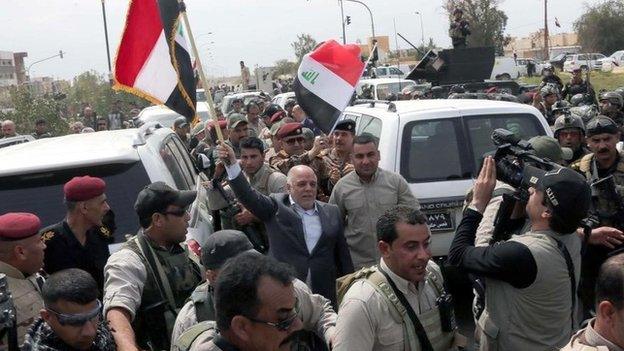
Iraqi Prime Minister Haider al-Abadi raised an Iraqi flag in Tikrit when it was recaptured
In April 2015, Iraqi government forces retook Tikrit after a month-long offensive that was seen as a key step towards eventually driving IS out of Mosul. The US claimed that IS had lost more than a quarter of its territory in Iraq, while cautioning that it was too early to say that the tide was turning.
While IS had undoubtedly lost significant numbers of fighters and much equipment in months of air strikes and fighting on the ground, the group remains resilient and capable of taking the initiative.
This was underscored when IS launched a ferocious assault on Ramadi in May, leading soldiers to withdraw and tens of thousands of civilians to flee.
Kobane: Inside the town devastated by fight against IS
Islamic State suffers setback in Kobane but battle continues
